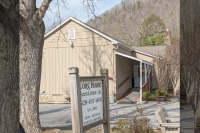The bugle of triumph: Elk herd success spurs tourism, scientific innovation
 At 7:30 a.m., darkness is just barely beginning to lift from the pre-dawn fields and forest of Cataloochee Valley. Joe Yarkovich steers his National Park Service vehicle through the valley and past a herd of elk bedded down in a field just past the ranger station. A handful of cars already lines the road, their occupants standing bundled outside holding binoculars and long-lensed cameras. We pass a few more fields, empty of both elk and people, before reaching a pull-off near the Caldwell House. An impressive bull and his harem of cows are practically on the road, close enough to toss a rock at. Or, more importantly, to make a great photo. I tighten my grip on the camera.
At 7:30 a.m., darkness is just barely beginning to lift from the pre-dawn fields and forest of Cataloochee Valley. Joe Yarkovich steers his National Park Service vehicle through the valley and past a herd of elk bedded down in a field just past the ranger station. A handful of cars already lines the road, their occupants standing bundled outside holding binoculars and long-lensed cameras. We pass a few more fields, empty of both elk and people, before reaching a pull-off near the Caldwell House. An impressive bull and his harem of cows are practically on the road, close enough to toss a rock at. Or, more importantly, to make a great photo. I tighten my grip on the camera.
“That’s the bull I was looking for,” says Yarkovich, a Great Smoky Mountains National Park wildlife biologist who specializes in elk. This particular elk had lost his radio collar when his neck swelled during mating season, called the rut — for that reason, Yarkovich typically replaces collars on male calves with larger ones as the animals mature.
As we near the group, they start heading into the woods. That’s typical for this time of day, this time of year, Yarkovich explains. The elk bed down in the fields at night and then head for tree cover as the sun comes up.
“Let’s get back to the other group,” Yarkovich says, referencing that first field of elk we’d passed. “They look like they’re going to be there for a while.”
So we turn around, park the SUV on the edge of the field of elk, and stand beside it, ready for the show to start. The rut, which spans most of September and October, brings out the dramatic side of elk. It’s when the bulls match their strength to determine who is most worthy of reproduction, and when the winners gather harems of cows around them, staving off any young upstarts who think they can steal a cow from the dominant bull. The race to pass on their genes is a full-time job for those large-antlered elk who win the game.
“It’s all day, basically, 24 hours a day,” Yarkovich says. “During the rut a bull loses an incredible amount of weight, 200 pounds of body weight, because they don’t take too much time to eat.”
Related Items
Instead, they’re bugling their decrees to the harem and to competing bulls, locking antlers if necessary, and, most importantly, mating with their females once they come into heat. That only happens for a 24-hour period once every three weeks, meaning that each female is available for a maximum of only three days during the six to eight weeks of the rut.
“There’s not a big window, which is why the bulls are constantly following them around,” Yarkovich said.
As the sun climbs higher above the horizon, more of the elk stand up from their beds in the field, the cows nibbling at the grass and the dominant bull surveying his domain. He’s huge, carrying a six-point rack that weighs close to 50 pounds. And he’s also a little put out by a younger male, a paltry little five-point thing, that’s hanging a bit too close to his harem.
The big bull lets out a bugle. It’s my first time ever hearing that sound, and I catch my breath, paging through the corners of my mind for something to compare it to. “Bugle” really seems the most accurate term, but in terms of comparisons in nature, I come up blank. But there’s nothing mechanical about it. It’s a wild sound.
“It doesn’t get old,” Yarkovich says, before backtracking. “Well, actually it can.”
Becoming The Elk Guy
Though he now lives in Maggie Valley with his wife, Yarkovich spent five years living in the ranger house in Cataloochee. One night, somewhere around 3 a.m., Yarkovich got fed up with the incessant bugling stealing his sleep. He came out of the house in his underwear, wielding a broom, bent on chasing those noisy creatures away so he could get some shut-eye. It was one of those situations, Yarkovich said, that causes you to reflect on what life choices you’ve made to lead to this moment.
Now headquartered at Oconaluftee, Yarkovich is still “The Elk Guy” and knows the herd as well as anyone. He’s been the go-to guy for elk since taking the job in 2006, five years after elk were first reintroduced to the park.
He can tell the bulls apart by their antlers — though he admits the females are all but impossible to distinguish — and he’s certain that the animals know the difference between him and the rest of the public, though he said rangers debate whether that’s because of uniforms, vehicles, body language or something else.
“They learn very well how to react to us,” Yarkovich said of himself and other park wildlife biologists. “The ones that we work over and over with paintballs, they learn exactly what distance they can get away with. They’re pretty bright.”
A paintball gun is Yarkovich’s park-issued defense against the massive bull elk. Yarkovich has no problem using clapped hands and a loud voice to scare off cows, and he does so multiple times as we drive up Cataloochee Valley together. But he says he always has a paintball gun in hand when facing a bull. The clear pellets do the job of scaring them away without hurting the animals, and the paintball guns are more palatable to visitors than guns loaded with beanbags.
His job is more than just curating the elk population — he also deals with bears, bats and any other wildlife issue that demands his attention. But the elk program, he said, “has kind of become my baby.”
He’s a fan of calving season, the time that determines what herd growth will look like for the next year, and he’s an admirer of the elk’s ability to adapt.
“The first couple years they were here, bears were killing most of their calves,” Yarkovich said. The elk had never seen bears before, and they didn’t know how to keep their calves safe.
He retold the story of Cow 15, who had her calf in the field that first year. A bear soon killed it, and the next year she went just inside the wood-line, but the calf still got taken. The third year, she trekked 6 miles through the woods to Balsam Mountain, and the calf survived. She’s done the same thing every year since.
“They’ve figured it out,” Yarkovich said. “Now predation from bears is a lot lighter.”
Beyond an experiment
The herd has come a long way since 2001, when 52 elk were released into Cataloochee Valley. The park radio collared each one, tracking their movements and reproductive success. It was a carefully monitored enterprise, and the herd stuck close to Cataloochee.
Not so anymore.
“It’s definitely gone from an experiment to a region-wide management issue,” Yarkovich said.
While Cataloochee is still the best place to see an elk, there’s a herd of about 25 that’s taken up residence in the Oconaluftee area of the park. Elk range east to U.S. 276 and south to U.S. 19 going through Maggie Valley. They’re in the Harmon Den area as well as Max Patch, and when young bulls disperse during the rut and right before it, the N.C. Wildlife Resources Commission has gotten calls from as far away as Cullowhee, Cashiers and Bryson City.
It’s hard to say exactly how many elk live in the Smokies right now. Standard methods for counting herd numbers are based on western terrains, which tend to be more open. Counting herds via a helicopter flyover wouldn’t work too well in wooded, hilly Appalachia.
“It’s at a point where we actually don’t know,” Yarkovich said. “I’m not giving people numbers because we don’t have any confidence in the numbers.”
That said, Justin McVey, district biologist for the Wildlife Resources Commission, puts the number at somewhere around 150, and a population analysis done in 2013 estimates a population growth rate of 1.074 percent since 2001, a slow but steady upward trend.
“It’s projecting good, strong growth,” Yarkovich said of the study.
With that growth comes more management challenges, and a scope that extends outside of the park. What originally began as a team-up to complete the 2013 study, which included an elk census, a plan to overcome elk-human conflict, studying population dynamics, a vegetation impact study and creating meadow habitats for elk to find food — a report is still being completed — has now turned into a more long-term coalition between the National Park Service, the Wildlife Resources Commission and the Eastern Band of Cherokee Indians.
“We’ve been doing a lot of work with habitat analysis to see if it’s feasible to expand the herd, and we’ve also been doing some surveys of folks to get their feeling on expansion of the herd,” said Justin McVey, district biologist for the Wildlife Resources Commission.
The Commission officially took over management of the herd in 2011, and McVey came on board to get the management efforts going in 2012. Besides collaring as many elk as possible, McVey’s role now involves a lot of conflict management between elk and people.
“I deal a lot with angry landowners,” McVey said. “It’s the same thing. They’re upset that they’re having damage, but they also respect the elk and the fact that it’s a magnificent creature.”
A more frequent sight
Joyce Cooper agrees with that description of the elk. The Cherokee resident is also the state chairperson for the Rocky Mountain Elk Foundation, an organization she belonged to well before there were any plans to bring the animals back to the Smokies.
“I was so thrilled when I saw my first elk in Yellowstone. I just thought it was the most majestic animal I had ever seen,” she said.
Now, she doesn’t have to travel 2,000 miles to see one.
“I came home from work and here lay this big elk right in the trees in my backyard,” she said. “I was so excited.”
In all likelihood, the elk will continue to spread. They’re a grass obligate species, meaning that they can live pretty much anywhere in the mountains where there’s enough grass to provide a dietary staple.
“What I imagine is going to happen is we’re going to stick to managing the herd that we do have and let that progress out naturally,” McVey said. “I expect the herd will start expanding out toward Max Patch and Harmon Den.”
A habitat analysis looked at factors such as vegetation cover, road locations and terrain to predict where elk might eventually wind up. It’s all a guessing game, but on paper the piedmont region looks like pretty great elk habitat, and Caswell County came out on top.
Improving the science
McVey, Yarkovich and Caleb Hickman, supervisory fish and wildlife biologist for the EBCI, are working together to come up with a better way to monitor — and therefore manage — the herd.
“We’re busting our butts and wracking our brains,” McVey said. “It’s going to be a long process.”
The group is throwing around a couple of different options for coming up with a whole-area estimate of the elk population.
One of those options would be a somewhat standard wildlife census technique known as mark-recapture. In this method, a certain number of animals are captured, tagged and then released. Then, the team sets about capturing as many animals as it can, recording how many are marked and how many are not. Through that process, they can come up with a proportion of marked to unmarked elk. That proportion can then be used to infer how many animals are out there total.
Another option would be much more difficult to get right but yield a treasure trove of data if perfected.
“It’s a challenging project, but the ideas are fairly solid,” said Hickman, who conceived the idea. “We wouldn’t be the first to do population work through genetics, but the way we’re doing it is fairly unique.”
Basically, this sampling technique would involve collecting elk droppings and testing them to determine how many unique individuals the pellets come from. When food passes through an animal’s intestines, some cells from inside the intestines slough off and come out with the waste.
“It’s a little CSI after that,” Hickman said. “You can figure out the individuals from that and have a particular number and give them a name. If you find it [the same individual] again down the road or on the trail you can figure out what their movements are, get the recapture rate, and if we have a high recapture rate we can have a good idea of what the population size is.”
It would be a similar idea, then, to the standard mark-recapture method, but extra sciency. Hickman is currently working with some scientists at the University of Georgia to figure out the method.
While fecal DNA testing in itself isn’t new, this proposed method would use something called “next-generation sequencing,” a technique Hickman describes as “not your standard genetics.”
The method would allow the group to figure out which elk are related, who they’re hanging out with and which groups are interacting. All that would lead to a greater understanding of how elk organize socially without having to tarp or tranquilize them.
“Right now it’s hypothetical because we haven’t gotten that far yet,” Hickman said. “We’re still trying to work out methods, and it does require expert opinion.”
Putting elk to work
Beyond the scientific benefit of learning more about how elk move and socialize, having a good population estimate would give the Wildlife Resources Commission a better idea of when to introduce the next milestone of the elk reintroduction: an elk season.
“It would bring a lot of money in would be one thing, a lot more tourism dollars and that kind of thing,” McVey said. “Hunting is a great tool for management, for keeping populations in check.”
“I hunt with my camera so I’m pretty content the way it is now, but if the herd ever gets large enough to do a hunt, I know it would thrill a whole lot of people,” added Cooper.
Between hotel stays, equipment purchases, gas fill-ups and meals out, hunters can contribute a good bit of cash to an economy. But elk season or not, the ungulates are already pulling their weight when it comes to tourism.
“Visitation to Cataloochee has doubled since we brought the elk back,” Yarkovich said.
If it weren’t for the harrowing one-lane gravel road leading in to that area of the park, it could be even higher.
A priceless sight
It’s hard to think about money, though, as morning sun illuminates the reds and oranges of peak fall color. The rays break through scattered cumulus clouds, lighting up the fields, backlighting the big bull’s rack.
That smaller guy still isn’t moving far enough away, so the big bull edges toward him. The smaller bull steps back, keeping distance, and the two animals engage in a walking-pace chase around the field, across the road and looping back around to where the cows graze. Finally the chase ends, the smaller bull defeated still. Maybe next year.
The big guy bugles his triumph.
It’s a sight that makes it hard to talk about research techniques, stapled scientific studies or economic impacts.
“How do you put value on people’s experience when they come down here and get to hear that bull bugling?” Yarkovich asks. “I think having that landscape as close to natural is a really important thing.”
Did you know?
• Historically, six subspecies of elk roamed North America. Now, only two are left. The Smokies elk are the Manitoban subspecies.
• Elk antlers are the fastest-growing tissue in the world. In the spring, they can grow up to 1 inch per day and reach 50 pounds in weight.
• Adult bull elk typically weigh 600 to 800 pounds.
• Females breed when they reach age 2 and usually raise one calf each year.
• Though predators, mainly black bears, can take elk calves, nothing lives in the woods that will take down an adult elk.
• The last native elk in North Carolina was killed in the 1790s.
Source: Rocky Mountain Elk Foundation and Great Smoky Mountains National Park









